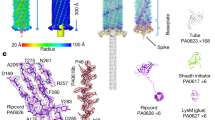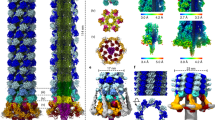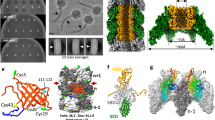Abstract
R-type pyocins are representatives of contractile ejection systems, a class of biological nanomachines that includes, among others, the bacterial type VI secretion system (T6SS) and contractile bacteriophage tails. We report atomic models of the Pseudomonas aeruginosa precontraction pyocin sheath and tube, and the postcontraction sheath, obtained by cryo-EM at 3.5-Å and 3.9-Å resolutions, respectively. The central channel of the tube is negatively charged, in contrast to the neutral and positive counterparts in T6SSs and phage tails. The sheath is interwoven by long N- and C-terminal extension arms emanating from each subunit, which create an extensive two-dimensional mesh that has the same connectivity in the extended and contracted state of the sheath. We propose that the contraction process draws energy from electrostatic and shape complementarities to insert the inner tube through bacterial cell membranes to eventually kill the bacteria.
This is a preview of subscription content, access via your institution
Access options
Subscribe to this journal
Receive 12 print issues and online access
$189.00 per year
only $15.75 per issue
Buy this article
- Purchase on Springer Link
- Instant access to full article PDF
Prices may be subject to local taxes which are calculated during checkout






Similar content being viewed by others
References
Bönemann, G., Pietrosiuk, A. & Mogk, A. Tubules and donuts: a type VI secretion story. Mol. Microbiol. 76, 815–821 (2010).
Basler, M., Pilhofer, M., Henderson, G.P., Jensen, G.J. & Mekalanos, J.J. Type VI secretion requires a dynamic contractile phage tail-like structure. Nature 483, 182–186 (2012).
French, C.T. et al. Dissection of the Burkholderia intracellular life cycle using a photothermal nanoblade. Proc. Natl. Acad. Sci. USA 108, 12095–12100 (2011).
Russell, A.B., Peterson, S.B. & Mougous, J.D. Type VI secretion system effectors: poisons with a purpose. Nat. Rev. Microbiol. 12, 137–148 (2014).
Aksyuk, A.A. et al. The tail sheath structure of bacteriophage T4: a molecular machine for infecting bacteria. EMBO J. 28, 821–829 (2009).
Kostyuchenko, V.A. et al. The tail structure of bacteriophage T4 and its mechanism of contraction. Nat. Struct. Mol. Biol. 12, 810–813 (2005).
Leiman, P.G., Chipman, P.R., Kostyuchenko, V.A., Mesyanzhinov, V.V. & Rossmann, M.G. Three-dimensional rearrangement of proteins in the tail of bacteriophage T4 on infection of its host. Cell 118, 419–429 (2004).
Hurst, M.R.H., Glare, T.R. & Jackson, T.A. Cloning Serratia entomophila antifeeding genes: a putative defective prophage active against the grass grub Costelytra zealandica. J. Bacteriol. 186, 5116–5128 (2004).
Yang, G., Dowling, A.J., Gerike, U., ffrench-Constant, R.H. & Waterfield, N.R. Photorhabdus virulence cassettes confer injectable insecticidal activity against the wax moth. J. Bacteriol. 188, 2254–2261 (2006).
Shikuma, N.J. et al. Marine tubeworm metamorphosis induced by arrays of bacterial phage tail–like structures. Science 343, 529–533 (2014).
Michel-Briand, Y. & Baysse, C. The pyocins of Pseudomonas aeruginosa. Biochimie 84, 499–510 (2002).
Williams, S.R., Gebhart, D., Martin, D.W. & Scholl, D. Retargeting R-type pyocins to generate novel bactericidal protein complexes. Appl. Environ. Microbiol. 74, 3868–3876 (2008).
Nakayama, K. et al. The R-type pyocin of Pseudomonas aeruginosa is related to P2 phage, and the F-type is related to lambda phage. Mol. Microbiol. 38, 213–231 (2000).
Kageyama, M., Ikeda, K. & Egami, F. Studies of a Pyocin. III. Biological properties of the pyocin. J. Biochem. 55, 59–64 (1964).
Scholl, D. et al. An engineered R-type pyocin is a highly specific and sensitive bactericidal agent for the food-borne pathogen Escherichia coli O157:H7. Antimicrob. Agents Chemother. 53, 3074–3080 (2009).
Ritchie, J.M. et al. An Escherichia coli O157-specific engineered pyocin prevents and ameliorates infection by E. coli O157:H7 in an animal model of diarrheal disease. Antimicrob. Agents Chemother. 55, 5469–5474 (2011).
Uratani, Y. & Hoshino, T. Pyocin R1 inhibits active transport in Pseudomonas aeruginosa and depolarizes membrane potential. J. Bacteriol. 157, 632–636 (1984).
Leiman, P.G. & Shneider, M.M. Contractile tail machines of bacteriophages. Adv. Exp. Med. Biol. 726, 93–114 (2012).
Arisaka, F., Engel, J. & Klump, H. Contraction and dissociation of the bacteriophage T4 tail sheath induced by heat and urea. Prog. Clin. Biol. Res. 64, 365–379 (1981).
Arisaka, F., Tschopp, J., Van Driel, R. & Engel, J. Reassembly of the bacteriophage T4 tail from the core-baseplate and the monomeric sheath protein P18: a co-operative association process. J. Mol. Biol. 132, 369–386 (1979).
To, C.M., Kellenberger, E. & Eisenstark, A. Disassembly of T-even bacteriophage into structural parts and subunits. J. Mol. Biol. 46, 493–511 (1969).
Aksyuk Anastasia, A. et al. Structural conservation of the Myoviridae phage tail sheath protein fold. Structure 19, 1885–1894 (2011).
Browning, C., Shneider, M.M., Bowman, V.D., Schwarzer, D. & Leiman, P.G. Phage pierces the host cell membrane with the iron-loaded spike. Structure 20, 326–339 (2012).
Harrison, S.C., Olson, A.J., Schutt, C.E., Winkler, F.K. & Bricogne, G. Tomato bushy stunt virus at 2.9 Å resolution. Nature 276, 368–373 (1978).
Abad-Zapatero, C. et al. Structure of southern bean mosaic virus at 2.8 Å resolution. Nature 286, 33–39 (1980).
Zhang, X. et al. A new topology of the HK97-like fold revealed in Bordetella bacteriophage by cryoEM at 3.5 Å resolution. eLife 2, e01299 (2013).
Mougous, J.D. et al. A virulence locus of Pseudomonas aeruginosa encodes a protein secretion apparatus. Science 312, 1526–1530 (2006).
Pell, L.G., Kanelis, V., Donaldson, L.W., Howell, P.L. & Davidson, A.R. The phage lambda major tail protein structure reveals a common evolution for long-tailed phages and the type VI bacterial secretion system. Proc. Natl. Acad. Sci. USA 106, 4160–4165 (2009).
Kanamaru, S. et al. Structure of the cell-puncturing device of bacteriophage T4. Nature 415, 553–557 (2002).
Remaut, H. et al. Fiber formation across the bacterial outer membrane by the chaperone/usher pathway. Cell 133, 640–652 (2008).
Jobichen, C. et al. Structural basis for the secretion of EvpC: a key type VI secretion system protein from Edwardsiella tarda. PLoS ONE 5, e12910 (2010).
Ho, B.T., Dong, T.G. & Mekalanos, J.J. A view to a kill: the bacterial type VI secretion system. Cell Host Microbe 15, 9–21 (2014).
Kube, S. et al. Structure of the VipA/B type VI secretion complex suggests a contraction-state-specific recycling mechanism. Cell Rep. 8, 20–30 (2014).
Krissinel, E. & Henrick, K. Inference of macromolecular assemblies from crystalline state. J. Mol. Biol. 372, 774–797 (2007).
Remaut, H. & Waksman, G. Protein–protein interaction through β-strand addition. Trends Biochem. Sci. 31, 436–444 (2006).
Clemens, D.L., Ge, P., Lee, B.-Y., Horwitz, M.A. & Zhou, Z.H. Atomic structure of T6SS reveals interlaced array essential to function. Cell 160, 940–951 (2015).
Kudryashev, M. et al. Structure of the type VI secretion system contractile sheath. Cell 160, 952–962 (2015).
Moody, M.F. Sheath of bacteriophage T4. 3. Contraction mechanism deduced from partially contracted sheaths. J. Mol. Biol. 80, 613–635 (1973).
King, J. & Mykolajewyoz, N. Bacteriophage T4 tail assembly: proteins of the sheath, core and baseplate. J. Mol. Biol. 75, 339–358 (1973).
Aksyuk, A.A. et al. The tail sheath structure of bacteriophage T4: a molecular machine for infecting bacteria. EMBO J. 28, 821–829 (2009).
Ge, P. & Zhou, Z.H. Chaperone fusion proteins aid entropy-driven maturation of class II viral fusion proteins. Trends Microbiol. 22, 100–106 (2014).
Ludtke, S.J., Baldwin, P.R. & Chiu, W. EMAN: semiautomated software for high-resolution single-particle reconstructions. J. Struct. Biol. 128, 82–97 (1999).
Ge, P. et al. Cryo-EM model of the bullet-shaped vesicular stomatitis virus. Science 327, 689–693 (2010).
Ge, P. & Zhou, Z.H. Hydrogen-bonding networks and RNA bases revealed by cryo electron microscopy suggest a triggering mechanism for calcium switches. Proc. Natl. Acad. Sci. USA 108, 9637–9642 (2011).
Egelman, E.H. Reconstruction of helical filaments and tubes. Methods Enzymol. 482, 167–183 (2010).
Scheres, S.H.W. RELION: implementation of a Bayesian approach to cryo-EM structure determination. J. Struct. Biol. 180, 519–530 (2012).
Emsley, P., Lohkamp, B., Scott, W.G. & Cowtan, K. Features and development of Coot. Acta Crystallogr. D Biol. Crystallogr. 66, 486–501 (2010).
Brunger, A.T. Version 1.2 of the Crystallography and NMR system. Nat. Protoc. 2, 2728–2733 (2007).
Adams, P.D. et al. PHENIX: a comprehensive Python-based system for macromolecular structure solution. Acta Crystallogr. D Biol. Crystallogr. 66, 213–221 (2010).
Pettersen, E.F. et al. UCSF Chimera: a visualization system for exploratory research and analysis. J. Comput. Chem. 25, 1605–1612 (2004).
Acknowledgements
We thank D. Martin of AvidBiotics for discussion and support throughout this project and UCLA undergraduate student J. Chiou for assistance in data processing. This research was supported in part by the US National Institutes of Health (NIH) (AI046420/AI094386 and GM071940 to Z.H.Z.). P.G. was supported in part by an American Heart Association Western States Affiliates Postdoctoral Fellowship (13POST17340020). We acknowledge the use of instruments at the Electron Imaging Center for Nanomachines, supported by UCLA and by instrumentation grants from the NIH (1S10RR23057). Recharge fees for access to this facility for imaging the pyocin samples were partially defrayed by an award to Z.H.Z. from the UCLA Clinical and Translational Science Institute core voucher program.
Author information
Authors and Affiliations
Contributions
Z.H.Z., J.F.M., P.G., D.S. and P.G.L. designed the experiments. Z.H.Z. supervised the execution of the experiments. D.S. prepared the crude pyocin sample. X.Y. purified the same sample. P.G. performed cryo-EM, processed the images and built the atomic models. All authors interpreted the results. P.G. and P.G.L. drafted the manuscript. P.G., P.G.L., Z.H.Z. and J.F.M. edited the manuscript, and all authors reviewed the final manuscript.
Corresponding author
Ethics declarations
Competing interests
J.F.M. is a cofounder, equity holder and chair of the scientific advisory board of AvidBiotics Inc., a biotherapeutics company in San Francisco.
Integrated supplementary information
Supplementary Figure 1 Surface charge of the top (left) and bottom (right) side of the tube hexamer.
Supplementary Figure 2 Electron microscopy images of the postcontraction pyocin R2.
Electron microscopy images of the pyocin R2 embedded in uranyl acetate stain (a) or vitreous ice (b). Arrows point to postcontraction pyocins.
Supplementary Figure 3 Conformational change during contraction.
(a and b) Superposition of a pre- and a postcontraction sheath subunit showing extend of conformation change in different regions during contraction. (c-g) Surface charge distributions of sheath subunits in their precontraction (c and d) and postcontraction (e-g) states. For clarity, the C domain of sheath is removed in panel g.
Supplementary Figure 4 Key interactions of neighboring sheath subunits in the precontraction state.
There are six neighbors for each sheath subunit. They are colored differently in the top panel; the central subunit is colored magenta. Between the magenta subunit and its six neighbors are interfaces, of which three are unique. Key residues or interactions on these interfaces are tabulated below.
Supplementary Figure 5 Key interactions of neighboring sheath subunits in the postcontraction state.
There are ten neighbors for each sheath subunit. They are colored differently in the top panel; the central subunit is colored magenta. Between the magenta subunit and its ten neighbors are interfaces, of which five are unique. Key residues or interactions on these interfaces are tabulated below.
Supplementary Figure 6 Resolution assessment and validation of the pre- and postcontraction structures.
(left column) Fourier shell correlation curves between maps calculated from half datasets (dark red) and between the atomic model and the map (navy blue) and R-Free factors (orange) are plotted in the same graph versus resolution, for the pre- (a) and postcontraction (b) states, respectively. (right column) Ramachandran plots for the pre- (a) and postcontraction (b) state structures. Occupancy of different areas in each plot is listed at the bottom side of it.
Supplementary information
Supplementary Text and Figures
Supplementary Figures 1–6 (PDF 869 kb)
Fly-by animation of the 3D montage model of the pyocin R2
Fly-by animation of the 3D montage model of the pyocin R2 in its entity rendered as shaded colour surface (coloured by cylindrical radius). (MP4 55682 kb)
Shaded surface view of the 3D cryo-EM density map of the precontraction trunk
Views matching Figure 1d-g are shown consecutively. (MP4 54777 kb)
Density map of the attachment helix of the sheath
The density map of the attachment helix of the sheath is shown as mesh superimposed with its atomic model (sticks). (MP4 10117 kb)
Density map of a β-sheet region
The density map of a β-sheet region of the tube is shown as mesh superimposed with its atomic (MP4 21869 kb)
Structure of the contracted sheath
Fly-by animation of the density map of the contracted sheath rendered as semi-transparent surface superimposed with its atomic model (ribbons). This scene is matching Figure 6b. (MP4 76409 kb)
Morphing between pre- and postcontraction states of the sheath
The morphing between pre- and post-contraction states of the sheath is shown in two orthogonal views. Two sequences are shown with different colour schemes: in the first sequence, the colour scheme is similar to that in Figure 3a; in the second, the subunits within the same disc are shown in the same colour. (MP4 39917 kb)
Zoom-in view of Video 8
Morphing between Figure 6c to Figure 6d. (MP4 2337 kb)
Possible way to preserve the augmented β-sheet of the sheath during contraction
Figure 3e is morphed into its post-contraction counterpart, shown in three views with 45° horizontal rotation in between. (MP4 8277 kb)
Rights and permissions
About this article
Cite this article
Ge, P., Scholl, D., Leiman, P. et al. Atomic structures of a bactericidal contractile nanotube in its pre- and postcontraction states. Nat Struct Mol Biol 22, 377–382 (2015). https://doi.org/10.1038/nsmb.2995
Received:
Accepted:
Published:
Issue Date:
DOI: https://doi.org/10.1038/nsmb.2995
This article is cited by
-
Cytoplasmic contractile injection systems mediate cell death in Streptomyces
Nature Microbiology (2023)
-
Pivotal role of O-antigenic polysaccharide display in the sensitivity against phage tail-like particles in environmental Pseudomonas kin competition
The ISME Journal (2022)
-
Poultry gut health – microbiome functions, environmental impacts, microbiome engineering and advancements in characterization technologies
Journal of Animal Science and Biotechnology (2021)
-
Live cell dynamics of production, explosive release and killing activity of phage tail-like weapons for Pseudomonas kin exclusion
Communications Biology (2021)
-
Computational image analysis of the baseplate-tail complex of O1 ElTor vibriophage M4
Archives of Virology (2020)



